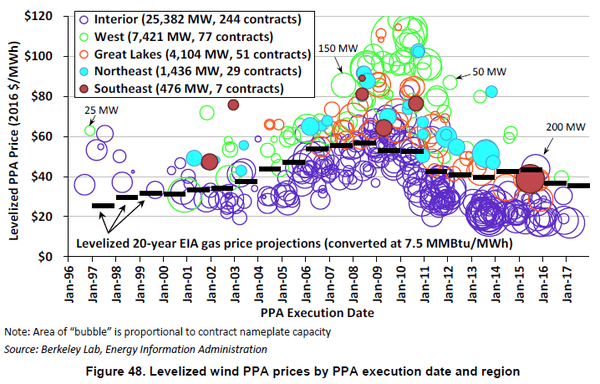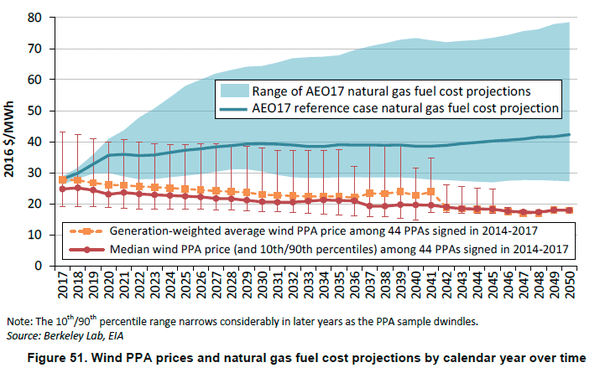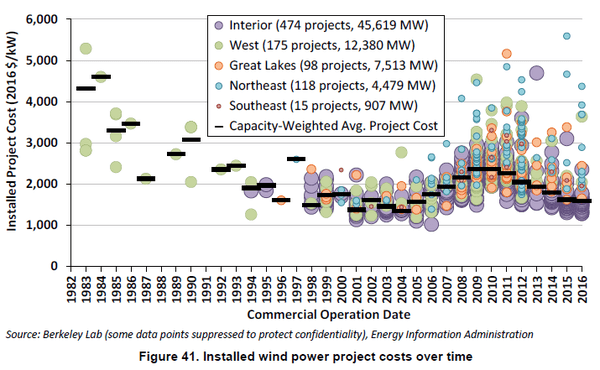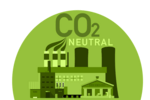News Release from American Clean Power Association (ACP)
Wind Industry Profile of
National lab: Wind power has become historically low-cost
LBNL’s findings confirm that U.S. wind energy costs continue to fall, technology continues to advance and performance continues to improve. This has helped the wind industry sell energy at historically low prices to electricity customers, increasing demand from utilities and corporate purchasers alike. As a result, the outlook for the industry is strong.
Let’s look at the report’s highlights:
Wind energy has become historically cheap
LBNL examined wind power purchase agreement (PPA) prices across the country, finding that the average levelized PPA price fell to about $20/megawatt hour (MWh) last year. That is a 66 percent price reduction since 2009. PPA prices have fallen across the country, varying by region, with the lowest prices found in the interior.

The low prices reported by LBNL confirm similar recent reports. For example, late last year Wall Street management firm Lazard reported a two-thirds reduction in the unsubsidized levelized cost of energy (LCOE) for wind since 2009.
As those other analysts have noted, wind energy is now the lowest-cost option among all energy sources. PPAs not only provide cost-competitive pricing today, they also allow utilities and corporate purchasers to secure price stability over periods of 10, 20, or even 30 years, providing a hedge against future fuel price increases.

It has gotten much cheaper to build new wind turbines
LBNL reported that it now costs 33 percent less, on average, to install a new wind turbine than the peak reported in 2009 and 2010. Similar to PPA price data, installed costs were lowest in the interior states. Installed costs include all expenses before a wind project comes online, including turbine purchases, balance of plant, and interconnection costs. As turbine purchases are considered the most expensive component of a wind project’s installed costs, decreases in turbine prices were cited by LBNL as the primary factor in cost decreases.

Technology advancements increased wind project performance
Cost reductions continued in 2016 even as wind turbines grew larger, which is a remarkable accomplishment. For turbines installed in 2016, LBNL reported a 13 percent increase in average rotor diameter length over the previous five-year average, as well as an 11 percent increase in average rated turbine capacity. These technology improvements enable wind turbines to optimize their performance and produce more electricity by reaching stronger, steadier winds. Increased rotor diameters in particular helped to boost new wind turbine performance, with wind projects built in 2014 and 2015 reporting a 42.5 percent average capacity factor in 2016, compared to 32.1 percent for projects built between 2004-2001.
A new finding from the report also reveals how increased performance is being pursued through site customization. That means different turbine models throughout the same wind farm are used to ensure projects reach peak performance. Nearly 25 percent of all wind projects installed in 2016 used multiple turbine configurations from the same turbine manufacturer.
Technology advancements increased wind project performance
Cost reductions continued in 2016 even as wind turbines grew larger, which is a remarkable accomplishment. For turbines installed in 2016, LBNL reported a 13 percent increase in average rotor diameter length over the previous 5-year average, as well as an 11 percent increase in average rated turbine capacity. These technology improvements enable wind turbines to optimize their performance and produce more electricity by reaching stronger, steadier winds. Increased rotor diameters in particular helped to boost new wind turbine performance, with wind projects built in 2014 and 2015 reporting a 42.5 percent average capacity factor in 2016, compared to a 32.1 percent capacity factor for projects built between 2004-2011.
A new finding from the report also reveals how increased performance is being pursued through site customization. That means different turbine models throughout the same wind farm are used to ensure projects reach peak performance. Nearly 25 percent of all wind projects installed in 2016 used multiple turbine configurations from the same turbine manufacturer.
The report supports AWEA data that wind power is now the leading source of renewable energy capacity in the country
The wind industry deployed 8,203 megawatts (MW) in 2016, for a total of 82,143 MW of installed capacity at the end of the year—enough to power 25 million average American homes. That strong installation activity pushed wind power past conventional hydropower to become the largest renewable energy capacity source in America. AWEA’s 2017 second quarter market report confirms strong continued activity, with new wind farm development up 40 percent over this time last year.
The outlook for the wind industry is strong
While the LBNL report notes strong growth is expected to continue through 2020, the report does conclude with a balanced discussion of factors affecting the outlook for the U.S. wind industry in the 2020s.
It lists many positive factors, including “the potential for continued technological advancements and cost reductions enhance the prospects for longer-term growth, as does burgeoning corporate demand for wind energy and continued state (renewable portfolio standard) requirements. Moreover, new transmission in some regions is expected to open up high-quality wind resources to development.”
Some have focused on the report’s discussion of potential economic challenges for the industry, including competition from natural gas and solar. However, it should be noted that those challenges are nothing new and have in fact been listed in every version of the report this decade. Thanks to the innovation and productivity of American workers, the wind industry has been able overcome those challenges by greatly exceeding cost reduction expectations, and we expect that successful track record to continue.
LBNL’s full report provides valuable insights on wind industry market and technology trends. We’re excited to see that wind energy is more cost-competitive than ever, with momentum in place to supply 10 percent of the country’s electricity by 2020, while adding another 50,000 jobs to our 100,000-strong wind energy workforce over the same time frame.
- Source:
- AWEA - Into the Wind Blog
- Author:
- Hannah Hunt
- Link:
- www.aweablog.org/...
- Keywords:
- USA; AWEA; Blog, National Lab, report, costs

























